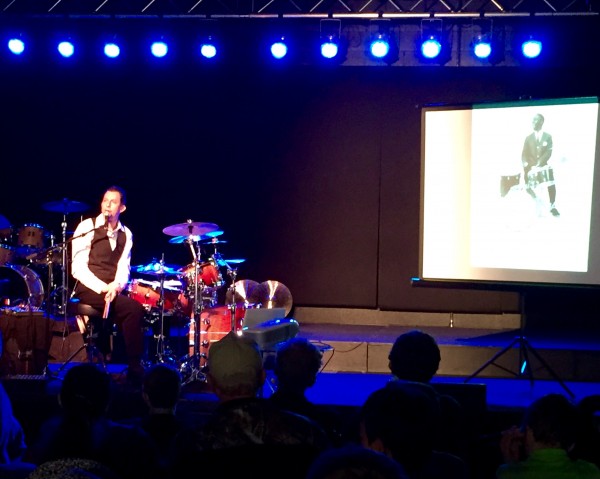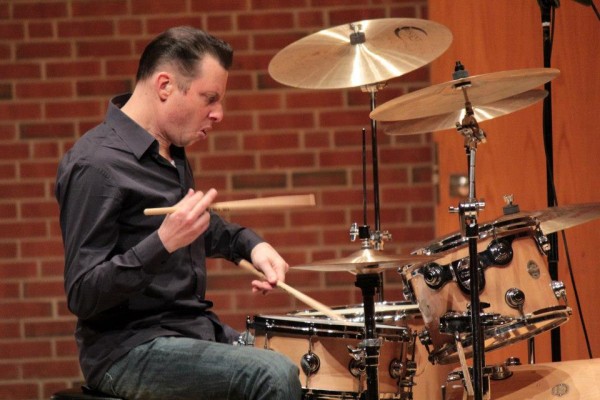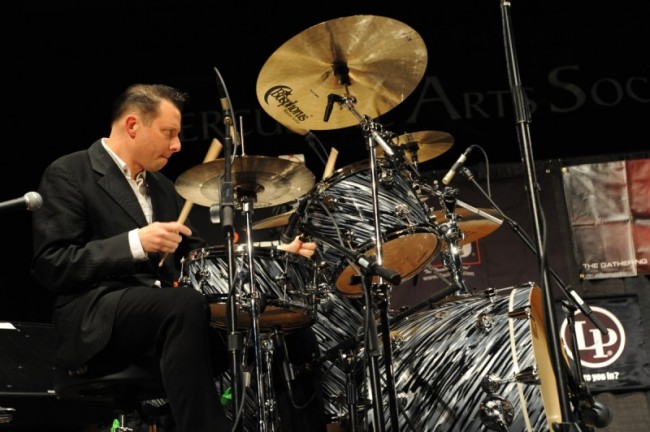The Influence of Radio
I’ve always loved music. When I was a kid, my parents refused to buy a television – they were sort of taking a stand against letting their children’s minds be rotted by television – so my sister and I became radio fanatics. We listened to the radio from morning till night, and really listened, perhaps more so than our peers. I think that set the course for my life as a musician, in terms of the way I thought about and understood music.
(photo: Jeremy Sibson)
Bonham and the Quarter Note Pulse
So, if you know me at all, you probably know that one of my favorite concepts to talk about as an educator is the QUARTER NOTE PULSE. This clip provides a fine example of how the approach toward “swinging” four quarter notes begun in the 1920s and ’30s was still going strong into the modern rock era.
Here’s Led Zeppelin playing “How Many More Times” in 1969. Note John Bonham’s RH on the ride cymbal. His technique (what I refer to as “throw-up”) belies an upbringing based in jazz studies and the influence of swinging drummers like Gene Krupa, Max Roach and Earl Palmer (remember, there was no such thing as a “rock drummer” or “rock technique” when Bonham was a lad in mid-fifties England). Even when the band fully kicks in to the groove, Bonham’s approach is still coming from a “swung 8th” perspective. It’s an important distinction to make, because the jazz/swing quarter note underpinning is what makes so much of 1950s and ’60s rock’n’roll so memorable.
The upshot is this: If you love Bonham, then do some research and learn what influenced him. You’ll discover some intricacies in rock you never realized, and will improve your playing as a result!
For a deeper discussion of my approach to this topic, check out the recent FREE LIVE LESSON I recently recorded with the good folks at Drumeo: http://bit.ly/1WLRukC
Singing And Snapping
Okay – big thought today. It’s a concept I put to all my jazz students, accompanied by a series of exercises called “Singing and Snapping.” Check it out and let me know what you think:
When practicing jazz comping figures on the snare, most drummers don’t think about the LENGTH of the notes they’re playing (quarters vs. 8ths, for example), only which BEAT they’re playing ON (the “and of 2,” for example). In other words, rather than thinking of each exercise as a “melody” (the way the other instrumentalists in the band would), they are only thinking about the placement of the notes – more like a math problem than music. What typically ends up happening is that the entire pattern sounds very staccato and the snare is much too loud compared to the other limbs. In order for us to express rhythmic phrases with a JAZZ awareness (meaning, the same as a sax or piano player would), we have to take into account the note LENGTHS (8th=short, Quarter=long) when we play them. The way to create this distinction is to first SING the phrases in the manner or other instrumentalists. Once we start expressing the notes as MUSIC (rather than simply rhythmic ideas), our hands will naturally follow in creating the appropriate feel. Get it?
Why Every Drummer Needs to Listen to Barry Manilow …
So why have I posted a picture of Barry Manilow on this fine Monday morning? No, it’s not to dump a spoonful of saccharin in your morning cup.
It’s because if you’re a drummer, you really need to watch the video below and see what happens at 0:54.
What you’ll hear is Manilow’s 1974 hit, “Mandy,” and what happens at 0:54 is that the drummer comes in. And what is the drummer doing, pray tell? Playing quarter notes on the hi hat is what. Why is this a big deal? Because it’s hard … REALLY hard on a song at a fairly moderate tempo such as this one.
Now keep listening, and you’ll notice that every time the drummer starts to play fills, they are comprised of 8th notes …. every time, the whole way through the song. Again, playing fills of this kind is actually really hard to do at tempos like this one.
What’s the upshot of all this? If you want to improve your straight eighth groove – get “deeper into the pocket” as it were – it would behoove you to play along with “Mandy” and other Manilow power pop ballads. They all follow the same drumming formula, and will really test your abilities not only to keep steady time, but to go in and out of fills without losing said time.
I learned this lesson firsthand when I worked with Graham Russell from Air Supply (yes, Air Supply) a few years back. I was tasked to cut a demo of a brand new Russell original for a Broadway project, and realized that my “power ballad” time wasn’t so hot. SO, in preparation for the recording, I spent three days in my practice space working on deathly slow rock grooves playing nothing but quarter notes on the hi hat and eighth note fills. It was a great lesson and those three days made me a much better drummer.
Try it – you’ll find a whole new appreciation of SPACE, something that most drummers are absolutely terrified of and have much trouble negotiating.









